Indirect Estimation of Structural Parameters in South African Forests Using MISR-HR and LiDAR Remote Sensing Data
Abstract
:1. Introduction
- Do off-nadir MISR-HR products significantly improve the estimation of structural parameters compared to those obtained with the nadir-pointing camera only?
- Which data channels or combinations thereof, have the greatest potential to improve the canopy structure models performance?
- Does the performance of predicting structural parameters improve whilst using the MISR-HR RPV model parameters (ρ0, k, Θ) compared to the full MISR-HR BRF multi-angle multi-spectral dataset (i.e., 4 spectral bands at nine view angles)?
2. Materials and Methods
2.1. South African Forested Landscapes and Study Area
2.2. LiDAR Data
2.3. LiDAR Processing and Derived Structural Parameters
- Tree height is defined as the vertical distance from the base of the tree to its treetop [71]. It plays a key role in forest ecosystem studies, for instance for predicting species richness and species distribution models [72,73] or for assessing fire severity and modelling fire escape mechanisms [74,75]. It contributes to estimate variables such as canopy volume and biomass [76,77]. The mean tree height (Hmean) parameter was calculated as the average of the CHM pixels excluding the non-tree pixels (<1 m) within each MISR-HR 275 m pixel. This is a useful measure especially in even-aged forests. There was a strong relationship between tree height estimated by the CAO CHMs and field measurements (R2 = 0.93, p-value < 0.001 and standard error of 0.73 m), as described in Wessels et al. [78].
- Canopy cover (CC) is defined as the percentage area of a MISR-HR 275 m pixel covered by the vertical projection of tree crowns. As a simple 2D structural measure, CC is a key descriptor of ecosystems and is useful for monitoring vegetation changes, for instance habitat connectivity and fragmentation [79,80,81]. This parameter was estimated by calculating the percentage of CHM pixels with a height above 1 m relative to the total number of LiDAR pixels included in a 275 m MISR pixel. A strong relationship between CAO LiDAR-derived CC and field measurements was previously demonstrated for the KNP dataset (R2 = 0.79, Root Mean Square Error (RMSE) of 12.4%) [17].
2.4. MISR Data and Processing
- The MISR L1B2 Terrain-projected Global Mode data, which contains top of atmosphere (TOA) radiance measurements, resampled at surface level and topographically corrected.
- The MISR L2 Terrain–projected bottom of atmosphere (BOA) bidirectional reflectance factors (BRFs), generated by NASA’s standard processing system at 1.1 km spatial resolution.
- Geometric Parameters Product (GPP).
- Ancillary Geographic Product (AGP), which are the reference datasets containing the full latitude/longitude information.
2.5. Data Analysis
- Scenario 0: The baseline reference scenario was set up to establish the expected performance of a RF model using a traditional approach based on the red and NIR spectral bands similar to that provided by the nadir-viewing instruments such as the MODIS instrument. These two MISR-HR datasets bands (at 275 m) have a similar pixel size to that of MODIS dataset (i.e., 250 m).
- Scenario 1: The first scenario considered all four spectral bands from the An (nadir) camera. This scenario was carried out to establish whether adding more spectral bands from the nadir-pointing cameras improves the predictive capacity of the RF model.
- Scenario 2: This second scenario sought to evaluate if angular data is superior to spectral data for the retrieval of the forest parameters, or vice versa. We developed a set of four models; each including all view angles for a single spectral band (i.e., one RF model for each of the MISR bands and involving all 9 cameras).
- Scenario 3: The third scenario assessed the RF model performance constrained by data in each view angle separately. It consisted of eight models including all spectral bands for each individual forward and aft viewing angle (i.e., off-nadir camera: Af, Bf, Cf, Df, Aa, Ba, Ca and Da).
- Scenario 4: The fourth scenario was carried out to ascertain whether the combined use of all MISR angular and spectral data (i.e., the 36 MISR-HR BRF data channels) improves the forest structural parameter retrievals compared to any of the previous scenarios and if it does by how much.
- Scenario 5: The fifth scenario assessed if the anisotropic BRF parameters provide additional benefits compared to the raw MISR-HR BRF data (scenario 4). Here, we tested four models, three models which assessed the performance of each individual RPV model parameter (ρ0, k, Θ) considering all spectral bands, and one additional model combining all three RPV parameters for all spectral bands.
3. Results
3.1. LiDAR Based Strucutural Variability
3.2. Retriaval Performance from Nadir Reflectance
3.3. Comparison of Spectral Information Versus Angular Performance
3.4. Comparison of Single Angular MISR Cameras
3.5. Contribution of All 36 MISR Data Channels
3.6. Contribution of MISR-HR RPV Model Paramters
3.7. Model Performance across Vegetation Types
4. Discussion
5. Conclusions
Author Contributions
Acknowledgments
Conflicts of Interest
References
- Brown, S. Measuring carbon in forests: Current status and future challenges. Environ. Pollut. 2002, 116, 363–372. [Google Scholar] [CrossRef]
- Gibbs, H.K.; Brown, S.; Niles, J.O.; Foley, J.A. Monitoring and estimating tropical forest carbon stocks: Making REDD a reality. Environ. Res. Lett. 2007, 2, 045023. [Google Scholar] [CrossRef]
- Davis, F.W.; Roberts, D. Stand structure in terrestrial ecosystems. In Methods in Ecosystem Science; Sala, O.E., Jackson, R.B., Mooney, H.A., Howarth, R.W., Eds.; Springer: New York, NY, USA, 2000. [Google Scholar]
- NFA. NATIONAL FORESTS ACT 84. 1998 [cited ACT 84 OF 1998; 1-82]. Available online: https://cer.org.za/virtual-library/legislation/national/biodiversity-and-conservation/national-forests-act-no-84-of-1998 (accessed on 8 September 2017).
- Simard, M.; Pinto, N.; Fisher, J.B.; Baccini, A. Mapping forest canopy height globally with spaceborne lidar. J. Geophys. Res. Biogeosci. 2011. [Google Scholar] [CrossRef]
- Hansen, M.C.; Potapov, P.V.; Moore, R.; Hancher, M.; Turubanova, S.A.; Tyukavina, A.; Thau, D.; Stehman, S.V.; Goetz, S.J.; Loveland, T.R.; et al. High-resolution global maps of 21st-century forest cover change. Science 2013, 342, 850–853. [Google Scholar] [CrossRef] [PubMed]
- Sexton, J.O.; Song, X.P.; Feng, M.; Noojipady, P.; Anand, A.; Huang, C.; Kim, D.H.; Collins, K.M.; Channan, S.; DiMiceli, C.; et al. Global, 30-m resolution continuous fields of tree cover: Landsat-based rescaling of MODIS vegetation continuous fields with lidar-based estimates of error. Int. J. Digit. Earth 2013, 6, 427–448. [Google Scholar] [CrossRef] [Green Version]
- Hansen, M.C.; Potapov, P.V.; Goetz, S.J.; Turubanova, S.; Tyukavina, A.; Krylov, A.; Kommareddy, A.; Egorov, A. Mapping tree height distributions in Sub-Saharan Africa using Landsat 7 and 8 data. Remote Sens. Environ. 2016, 185, 221–232. [Google Scholar] [CrossRef] [Green Version]
- Scholes, R.J.; Von Maltitz, G.P.; Archibald, S.A.; Wessels, K.; Van Zyl, T.; Swanepoel, D.; Steenkamp, K. National Carbon Sink Assessment for South Africa First Estimate of Terestrial Stocks and Fluxes; CSIR: Pretoria, South Africa, 2013; pp. 1–38. [Google Scholar]
- Montesano, P.M.; Neigh, C.S.R.; Sexton, J.; Feng, M.; Channan, S.; Ranson, K.J.; Townshend, J.R. Calibration and Validation of Landsat Tree Cover in the Taiga−Tundra Ecotone. Remote Sens. 2016, 8, 551. [Google Scholar] [CrossRef]
- Wulder, M. Optical remote-sensing techniques for the assessment of forest inventory and biophysical parameters. Prog. Phys. Geogr. 1998, 22, 449–476. [Google Scholar] [CrossRef]
- Lu, D. The potential and challenge of remote sensing-based biomass estimation. Int. J. Remote Sens. 2006, 27, 1297–1328. [Google Scholar] [CrossRef]
- Dubayah, R.O.; Drake, J.B. Lidar remote sensing for forestry. J. For. 2000, 98, 44–46. [Google Scholar]
- Andersen, H.E.; McGaughey, R.J.; Reutebuch, S.E. Estimating forest canopy fuel parameters using LIDAR data. Remote Sens. Environ. 2005, 94, 441–449. [Google Scholar] [CrossRef]
- Castel, T.; Beaudoin, A.; Trouche, G. Analysis of SAR interferometry for tree height estimation over hilly forested area. Agricultura (Slovenia) 2002, 1, 15–23. [Google Scholar]
- Huang, S.; Hager, S.A.; Halligan, K.Q.; Fairweather, I.S.; Swanson, A.K.; Crabtree, R.L. A comparison of individual tree and forest plot height derived from lidar and InSAR. Photogramm. Eng. Remote Sens. 2009, 75, 159–167. [Google Scholar] [CrossRef]
- Naidoo, L.; Mathieu, R.; Main, R.; Kleynhans, W.; Asner, G.; Leblon, B. Savannah woody structure modelling and mapping using multi-frequency (X-, C-and L-band) Synthetic Aperture Radar data. ISPRS J. Photogramm. Remote Sens. 2015, 105, 234–250. [Google Scholar] [CrossRef]
- Hyde, P.; Dubayah, R.; Walker, W.; Blair, J.B.; Hofton, M.; Hunsaker, C. Mapping forest structure for wildlife habitat analysis using multi-sensor (LiDAR, SAR/InSAR, ETM+, Quickbird) synergy. Remote Sens. Environ. 2006, 102, 63–73. [Google Scholar] [CrossRef]
- Kellndorfer, J.; Walker, W.S.; LaPoint, E.; Kirsch, K.; Bishop, J.; Fiske, G. Statistical fusion of Lidar, InSAR, and optical remote sensing data for forest stand height characterization: A regional-scale method based on LVIS, SRTM, Landsat ETM+, and ancillary data sets. J. Geophys. Res. Biogeosci. 2010. [Google Scholar] [CrossRef]
- Cartus, O.; Kellndorfer, J.; Rombach, M.; Walker, W. Mapping Canopy Height and Growing Stock Volume Using Airborne Lidar, ALOS PALSAR and Landsat ETM+. Remote Sens. 2012, 4, 3320–3345. [Google Scholar] [CrossRef] [Green Version]
- Watt, P.J.; Donoghue, D.N.M.; McManus, K.B.; Dunfor, R.W. Predicting forest height from IKONOS, LANDSAT and LIDAR imagery. Age 2000, 33, 8. [Google Scholar]
- Mutanga, O.; Adam, E.; Cho, M.A. High density biomass estimation for wetland vegetation using WorldView-2 imagery and random forest regression algorithm. Int. J. Appl. Earth Observ. Geoinf. 2012, 18, 399–406. [Google Scholar] [CrossRef]
- Liang, S.; Strahler, A.H.; Barnsley, M.J.; Borel, C.C.; Gerstl, S.A.W.; Diner, D.J.; Prata, A.J.; Walthall, C.L. Multiangle remote sensing: Past, present and future. Remote Sens. Rev. 2000, 18, 83–102. [Google Scholar] [CrossRef]
- Verstraete, M.M.; Pinty, B. Introduction to special section: Modeling, measurement, and exploitation of anisotropy in the radiation field. J. Geophys. Res. Atmos. 2001, 106, 11903–11907. [Google Scholar] [CrossRef]
- Asner, G.P. Contributions of multi-view angle remote sensing to land-surface and biogeochemical research. Remote Sens. Rev. 2000, 18, 137–162. [Google Scholar] [CrossRef]
- Widlowski, J.; Pinty, B.; Gobron, N.; Verstraete, M.M.; Diner, D.J.; Davis, A.B. Canopy structure parameters derived from multi-angular remote sensing data for terrestrial carbon studies. Clim. Chang. 2004, 67, 403–415. [Google Scholar] [CrossRef]
- Chen, J.; Menges, C.; Leblanc, S. Global mapping of foliage clumping index using multi-angular satellite data. Remote Sens. Environ. 2005, 97, 447–457. [Google Scholar] [CrossRef]
- Huber, S.; Koetz, B.; Psomas, A.; Kneubuehler, M.; Schopfer, J.T. Impact of multiangular information on empirical models to estimate canopy nitrogen concentration in mixed forest. J. Appl. Remote Sens. 2010. [Google Scholar] [CrossRef] [Green Version]
- Martonchik, J.V.; Diner, D.J.; Pinty, B.; Verstraete, M.M.; Myneni, R.B.; Knyazikhin, Y.; Gordon, H.R. Determination of land and ocean reflective, radiative, and biophysical properties using multiangle imaging. IEEE Trans. Geosci. Remote Sens. 1998, 36, 1266–1281. [Google Scholar] [CrossRef] [Green Version]
- Martonchik, J.V.; Bruegge, C.J.; Strahler, A.H. A review of reflectance nomenclature used in remote sensing. Remote Sens. Rev. 2000, 19, 9–20. [Google Scholar] [CrossRef]
- Kumar, L.; Schmidt, K.; Dury, S.; Skidmore, A. Imaging spectrometry and vegetation science. In Imaging Spectrometry; van der Meer, F.D., De Jong, S.M., Eds.; Springer: Dordrecht, The Netherlands, 2002. [Google Scholar]
- Asner, G.P.; Bateson, C.; Privette, J.L.; El Saleous, N.; Wessman, C.A. Estimating vegetation structural effects on carbon uptake using satellite data fusion and inverse modeling. J. Geophys. Res. Atmos. 1998, 103, 28839–28853. [Google Scholar] [CrossRef] [Green Version]
- Kimes, D.; Nelson, R.F.; Manry, M.T.; Fung, A.K. Review article: Attributes of neural networks for extracting continuous vegetation variables from optical and radar measurements. Int. J. Remote Sens. 1998, 19, 2639–2663. [Google Scholar] [CrossRef]
- Diner, D.J.; Braswell, B.H.; Davies, R.; Gobron, N.; Hu, J.; Jin, Y.; Kahn, R.A.; Knyazikhin, Y.; Loeb, N.; Loeb, N.; et al. The value of multiangle measurements for retrieving structurally and radiatively consistent properties of clouds, aerosols, and surfaces. Remote Sens. Environ. 2005, 97, 495–518. [Google Scholar] [CrossRef]
- Chopping, M.J. Terrestrial applications of multiangle remote sensing. In Advances in Land Remote Sensing; Springer: Dordrecht, The Netherlands, 2008. [Google Scholar]
- Asner, G.P.; Braswell, B.H.; Schimel, D.S.; Wessman, C.A. Ecological research needs from multiangle remote sensing data. Remote Sens. Environ. 1998, 63, 155–165. [Google Scholar] [CrossRef]
- Diner, D.J.; Asner, G.P.; Davies, R.; Knyazikhin, Y.; Muller, J.; Nolin, A.W.; Pinty, B.; Schaaf, C.B.; Stroeve, J. New Directions in Earth Observing: Scientific Applications ofMultiangle Remote Sensing. Bull. Am. Meteorol. Soc. 1999, 80, 2209–2228. [Google Scholar] [CrossRef] [Green Version]
- Gobron, N.; Pinty, B.; Verstraete, M.M.; Martonchik, J.V.; Knyazikhin, Y.; Diner, D.J. Potential of multiangular spectral measurements to characterize land surfaces- Conceptual approach and exploratory application. J. Geophys. Res. 2000, 105, 17539–17549. [Google Scholar] [CrossRef]
- Schlerf, M.; Atzberger, C. Vegetation structure retrieval in beech and spruce forests using spectrodirectional satellite data. IEEE J. Sel. Top. Appl. Earth Obs. Remote Sens. 2012, 5, 8–17. [Google Scholar] [CrossRef]
- Gobron, N.; Pinty, B.; Verstraete, M.M.; Widlowski, J.L.; Diner, D.J. Uniqueness of multiangular measurements. II. Joint retrieval of vegetation structure and photosynthetic activity from MISR. IEEE Trans. Geosci. Remote Sens. 2002, 40, 1574–1592. [Google Scholar]
- Pinty, B.; Widlowski, J.L.; Gobron, N.; Verstraete, M.M.; Diner, D.J. Uniqueness of multiangular measurements. I. An indicator of subpixel surface heterogeneity from MISR. IEEE Trans. Geosci. Remote Sens. 2002, 40, 1560–1573. [Google Scholar] [CrossRef]
- Widlowski, J.L.; Pinty, B.; Gobron, N.; Verstraete, M.M.; Davis, A.B. Characterization of surface heterogeneity detected at the MISR/TERRA subpixel scale. Geophys. Res. Lett. 2001, 28, 4639–4642. [Google Scholar] [CrossRef] [Green Version]
- Chopping, M.J.; Rango, A.; Havstad, K.M.; Schiebe, F.R.; Ritchie, J.C.; Schmugge, T.J.; French, A.N.; Su, L.; McKee, L.; Davis, M.R. Canopy attributes of desert grassland and transition communities derived from multiangular airborne imagery. Remote Sens. Environ. 2003, 85, 339–354. [Google Scholar] [CrossRef]
- Heiskanen, J. Tree cover and height estimation in the Fennoscandian tundra–taiga transition zone using multiangular MISR data. Remote Sens. Environ. 2006, 103, 97–114. [Google Scholar] [CrossRef]
- Rahman, H.; Pinty, B.; Verstraete, M.M. Coupled surface-atmosphere reflectance (CSAR) model, 2, Semiempirical surface model usable with NOAA advanced very high resolution radiometer data. J. Geophys. Res. Atmos. 1993, 98, 20791–20801. [Google Scholar] [CrossRef]
- Engelsen, O.; Pinty, B.; Verstraete, M.M.; Martonchik, J.V. Parametric Bidirectional Reflectance Factor Models: Evaluation, Improvements and Applications; EC Joint Research Centre: Brussels, Belgium, 1996. [Google Scholar]
- Lavergne, T.; Kaminski, T.; Pinty, B.; Taberner, M.; Gobron, N.; Verstraete, M.M.; Vossbeck, M.; Widlowski, J.; Giering, R. Application to MISR land products of an RPV model inversion package using adjoint and Hessian codes. Remote Sens. Environ. 2007, 107, 362–375. [Google Scholar] [CrossRef]
- Armston, J.D.; Scarth, P.F.; Phinn, S.R.; Danaher, T.J. Analysis of multi-date MISR measurements for forest and woodland communities, Queensland, Australia. Remote Sens. Environ. 2007, 107, 287–298. [Google Scholar] [CrossRef]
- Beland, M.; Fournier, R. Extracting Savanna Tree Structure Parameters from Multi-Angular Remote Sensing. In Proceedings of the IGARSS 2008-2008 IEEE International Geoscience and Remote Sensing Symposium, Boston, MA, USA, 7–11 July 2008. [Google Scholar]
- Chopping, M.; North, M.; Chen, J.; Schaaf, C.B.; Blair, J.B.; Martonchik, J.V.; Bull, M.A. Forest canopy cover and height from MISR in topographically complex southwestern US landscapes assessed with high quality reference data. IEEE J. Sel. Top. Appl. Earth Obs. Remote Sens. 2012, 5, 44–58. [Google Scholar] [CrossRef]
- Armston, J.D.; Phinn, S.R.; Scarth, P.F.; Danaher, T.J. Analysis of Multiangle Imaging SpectroRadiometer (MISR) measurements in the Queensland Southern Brigalow belt. In Proceedings of the Twelfth Australasian Remote Sensing & Photogrammetry Conference, Fremantle, Australia, 18–22 October 2004. [Google Scholar]
- Chopping, M. Geometric-optical modeling with MISR over the Kola Peninsula. In Proceedings of the 2012 IEEE International Geoscience and Remote Sensing, Munich, Germany, 22–27 July 2012. [Google Scholar]
- Verstraete, M.M.; Hunt, L.A.; Scholes, R.J.; Clerici, M.; Pinty, B.; Nelson, D.L. Generating 275-m resolution land surface products from the Multi-Angle Imaging Spectroradiometer data. IEEE Trans. Geosci. Remote Sens. 2012, 50, 3980–3990. [Google Scholar] [CrossRef]
- Zhang, Y.; Shabanov, N.; Knyazikhin, Y.; Myneni, R.B. Assessing the information content of multiangle satellite data for mapping biomes: II. Theory. Remote Sens. Environ. 2002, 80, 435–446. [Google Scholar] [CrossRef]
- Nolin, A.W. Towards retrieval of forest cover density over snow from the Multi-angle Imaging SpectroRadiometer (MISR). Hydrol. Proc. 2004, 18, 3623–3636. [Google Scholar] [CrossRef]
- Low, B.; Rebelo, A.G. Vegetation of Southern Africa, Lesotho and Swaziland: A Companion to the Vegetation Map of South Africa, Lesotho and Swaziland; South African National Biodiversity Institute: Pretoria, South Africa, 1996. [Google Scholar]
- Fairbanks, D.H.K.; Scholes, R.J. South African Country Study on Climate Change: Vulnerability and Adaptation Assessment for Plantation Forestry; CSIR Environmentek Report ENV/C/99; CSIR: Pretoria, South Africa, 1999. [Google Scholar]
- Shackleton, C.M.; Griffin, N.J.; Banks, D.I.; Mavrandonis, J.M.; Shackleton, S.E. Community structure and species composition along a disturbance gradient in a communally managed South African savanna. Vegetatio 1994, 115, 157–167. [Google Scholar]
- Mucina, L.; Rutherford, M.C. The vegetation of South Africa, Lesotho and Swaziland. (Vol 19 of Strelitzia); South African National Biodiversity Institute: Pretoria, South Africa, 2006; pp. 438–697. [Google Scholar]
- Archibald, S.; Scholes, R. Leaf green-up in a semi-arid African savanna–separating tree and grass responses to environmental cues. J. Veg. Sci. 2007, 18, 583–594. [Google Scholar]
- Von Maltitz, G.; Mucina, L.; Geldenhuys, C.; Lawes, M.J.; Eeley, H.; Adie, H.; Vink, D.; Fleming, G.; Bailey, C. Classification system for South African indigenous forests: An objective classification for the Department of Water Affairs and Forestry. Environ. Rep. ENV-PC 2003, 17, 1–284. [Google Scholar]
- Neumann, F.H.; Scott, L.; Bousman, C.B.; Van As, L.A. Holocene sequence of vegetation change at Lake Eteza, coastal KwaZulu-Natal, South Africa. Rev. Palaeobot. Palynol. 2010, 162, 39–53. [Google Scholar] [CrossRef]
- Eeley, H.A.; Lawes, M.J.; Piper, S.E. The influence of climate change on the distribution of indigenous forest in KwaZulu-Natal, South Africa. J. Biogeogr. 1999, 26, 595–617. [Google Scholar] [CrossRef]
- Eeley, H.A.; Lawes, M.J.; Reyers, B. Priority areas for the conservation of subtropical indigenous forest in southern Africa: A case study from KwaZulu-Natal. Biodivers. Conserv. 2001, 10, 1221–1246. [Google Scholar] [CrossRef]
- Ismail, R.; Kassier, H.; Chauke, M.; Holecz, F.; Hattingh, N. Assessing the utility of ALOS PALSAR and SPOT 4 to predict timber volumes in even-aged Eucalyptus plantations located in Zululand, South Africa. South. For. J. For. Sci. 2015, 77, 203–211. [Google Scholar] [CrossRef]
- Tesfamichael, S.G.; van Aardt, J.A.N.; Ahmed, F. Estimating plot-level tree height and volume of Eucalyptus grandis plantations using small-footprint, discrete return lidar data. Prog. Phys. Geogr. 2010, 34, 515–540. [Google Scholar] [CrossRef] [Green Version]
- Dube, T.; Mutanga, O.; Elhadi, A.; Ismail, R. Intra-and-inter species biomass prediction in a plantation forest: Testing the utility of high spatial resolution spaceborne multispectral rapideye sensor and advanced machine learning algorithms. Sensors 2014, 14, 15348–15370. [Google Scholar] [CrossRef] [PubMed]
- Dube, T.; Mutanga, O. Evaluating the utility of the medium-spatial resolution Landsat 8 multispectral sensor in quantifying aboveground biomass in uMgeni catchment, South Africa. ISPRS J. Photogramm. Remote Sens. 2015, 101, 36–46. [Google Scholar] [CrossRef]
- Asner, G.P.; Knapp, D.E.; Boardman, J.; Green, R.O.; Kennedy-Bowdoin, T.; Eastwood, M. Carnegie Airborne Observatory-2: Increasing science data dimensionality via high-fidelity multi-sensor fusion. Remote Sens. Environ. 2012, 124, 454–465. [Google Scholar] [CrossRef]
- Asner, G.P.; Mascaro, J.; Muller-Landau, H.C.; Vieilledent, G.; Vaudry, R.; Rasamoelina, M.; Hall, J.S.; Van Breugel, M. A universal airborne LiDAR approach for tropical forest carbon mapping. Oecologia 2012, 168, 1147–1160. [Google Scholar] [CrossRef] [PubMed]
- Holmgren, J.; Nilsson, M.; Olsson, H. Estimation of tree height and stem volume on plots using airborne laser scanning. For. Sci. 2003, 49, 419–428. [Google Scholar]
- Wolf, J.A.; Fricker, G.A.; Meyer, V.; Hubbell, S.P.; Gillespie, T.W.; Saatchi, S.S. Plant Species Richness is Associated with Canopy Height and Topography in a Neotropical Forest. Remote Sens. 2012, 4, 4010–4021. [Google Scholar] [CrossRef] [Green Version]
- Hernández-Stefanoni, J.L.; Dupuy, J.M.; Johnson, K.D.; Birdsey, R.; Tun-Dzul, F.; Peduzzi, A.; Caamal-Sosa, J.P.; Sánchez-Santos, G.; López-Merlín, D. Improving Species Diversity and Biomass Estimates of Tropical Dry Forests Using Airborne LiDAR. Remote Sens. 2014, 6, 4741–4763. [Google Scholar] [CrossRef] [Green Version]
- Lawes, M.J.; Adie, H.; Russell-Smith, J.; Murphy, B.; Midgley, J.J. How do small savanna trees avoid stem mortality by fire? The roles of stem diameter, height and bark thickness. Ecosphere 2011, 2, 1–13. [Google Scholar] [CrossRef]
- Collins, B.M.; Kramer, H.A.; Menning, K.; Dillingham, C.; Saah, D.; Stine, P.A.; Stephens, S.L. Modeling hazardous fire potential within a completed fuel treatment network in the northern Sierra Nevada. For. Ecol. Manag. 2013, 310, 156–166. [Google Scholar] [CrossRef]
- Lefsky, M.A.; Harding, D.J.; Keller, M.; Cohen, W.B.; Carabajal, C.C.; Del Bom Espirito-Santo, F.; Hunter, M.O.; de Oliveira, R., Jr. Estimates of forest canopy height and aboveground biomass using ICESat. Geophys. Res. Lett. 2005, 32. [Google Scholar] [CrossRef] [Green Version]
- Breidenbach, J.; Koch, B.; Kändler, G.; Kleusberg, A. Comparison of Lidar and InSAR data to estimate tree height in forest inventories. In Proceedings of the International Workshop 3D Remote Sensing in Forestry, Vienna, Austria, 14–15 February 2006. [Google Scholar]
- Wessels, K.J.; Mathieu, R.; Erasmus, B.F.N.; Asner, G.P.; Smit, I.P.J.; Van Aardt, J.A.N.; Main, R.; Fisher, J.; Marais, W.; Kennedy-Bowdoin, T.; et al. Impact of communal land use and conservation on woody vegetation structure in the Lowveld savannas of South Africa. For. Ecol. Manag. 2011, 261, 19–29. [Google Scholar] [CrossRef]
- Posa, M.R.C.; Sodhi, N.S. Effects of anthropogenic land use on forest birds and butterflies in Subic Bay, Philippines. Biol. Conserv. 2006, 129, 256–270. [Google Scholar] [CrossRef]
- Rueda, M.; Saiz, J.C.M.; Morales-Castilla, I.; Albuquerque, F.S.; Ferrero, M.; Rodríguez, M.Á. Detecting fragmentation extinction thresholds for forest understory plant species in Peninsular Spain. PLoS ONE 2015, 10, e0126424. [Google Scholar] [CrossRef] [PubMed] [Green Version]
- Shapiro, A.C.; Aguilar-Amuchastegui, N.; Hostert, P.; Bastin, J.F. Using fragmentation to assess degradation of forest edges in Democratic Republic of Congo. Carbon Balance Anag. 2016, 11, 1–15. [Google Scholar] [CrossRef] [PubMed]
- Diner, D.J.; Beckert, J.C.; Reilly, T.H.; Bruegge, C.J.; Conel, J.E.; Kahn, R.A.; Martonchik, J.V.; Ackerman, T.P.; Davies, R.; Gerstl, S.A.W.; et al. Multi-angle Imaging SpectroRadiometer (MISR) instrument description and experiment overview. IEEE Trans. Geosci. Remote Sens. 1998, 36, 1072–1087. [Google Scholar] [CrossRef]
- Cuthbertson, A.J. Gaussian Processes for Temporal and Spatial Pattern Analysis in the MISR Satellite Land-Surface Data. Master’s Thesis, University of the Witwatersrand, Johannesburg, South Africa, 2014. [Google Scholar]
- GeoTerraImage. 2013-2014 South African National Land-Cover Dataset: Data User Report and Metadata; version 05#2; 2015. Available online: https://egis.environment.gov.za/data_egis/data_download/current (accessed on 16 April 2017).
- Liu, Z.; Verstraete, M.M.; de Jager, G. Handling outliers in model inversion studies: A remote sensing case study using MISR-HR data in South Africa. S. Afr. Geogr. J. 2017, 100, 122–139. [Google Scholar] [CrossRef]
- Breiman, L. Random forests. Mach. Learn. 2001, 45, 5–32. [Google Scholar] [CrossRef]
- Sedano, F.; Lavergne, T.; Ibaňez, L.M.; Gong, P. A neural network-based scheme coupled with the RPV model inversion package. Remote Sens. Environ. 2008, 112, 3271–3283. [Google Scholar] [CrossRef]
- Chen, G.; Hay, G.J. A support vector regression approach to estimate forest biophysical parameters at the object level using airborne lidar transects and quickbird data. Photogramm. Eng. Remote Sens. 2011, 77, 733–741. [Google Scholar] [CrossRef]
- Su, L.; Chopping, M.J.; Rango, A.; Martonchik, J.V.; Peters, D.P. Support vector machines for recognition of semi-arid vegetation types using MISR multi-angle imagery. Remote Sens. Environ. 2007, 107, 299–311. [Google Scholar] [CrossRef]
- Kimes, D.S.; Ranson, K.J.; Sun, G.; Blair, J.B. Predicting lidar measured forest vertical structure from multi-angle spectral data. Remote Sens. Environ. 2006, 100, 503–511. [Google Scholar] [CrossRef]
- Ismail, R.; Mutanga, O.; Kumar, L. Modeling the potential distribution of pine forests susceptible to sirex noctilio infestations in Mpumalanga, South Africa. Trans. GIS 2010, 14, 709–726. [Google Scholar] [CrossRef]
- Yu, X.; Hyyppä, J.; Vastaranta, M.; Holopainen, M.; Viitala, R. Predicting individual tree attributes from airborne laser point clouds based on the random forests technique. ISPRS J. Photogramm. Remote Sens. 2011, 66, 28–37. [Google Scholar] [CrossRef]
- Ali, I.; Greifeneder, F.; Stamenkovic, J.; Neumann, M.; Notarnicola, C. Review of Machine Learning Approaches for Biomass and Soil Moisture Retrievals from Remote Sensing Data. Remote Sens. 2015, 7, 16398–16421. [Google Scholar] [CrossRef] [Green Version]
- García-Gutiérrez, J.; Martínez-Álvarez, F.; Troncoso, A.; Riquelme, J.C. A comparison of machine learning regression techniques for LiDAR-derived estimation of forest variables. Neurocomputing 2015, 167, 24–31. [Google Scholar] [CrossRef] [Green Version]
- Prasad, A.M.; Iverson, L.R.; Liaw, A. Newer classification and regression tree techniques: Bagging and random forests for ecological prediction. Ecosystems 2006, 9, 181–199. [Google Scholar] [CrossRef]
- Hudak, A.T.; Crookston, N.L.; Evans, J.S.; Hall, D.E.; Falkowski, M.J. Nearest neighbor imputation of species-level, plot-scale forest structure attributes from LiDAR data. Remote Sens. Environ. 2008, 112, 2232–2245. [Google Scholar] [CrossRef]
- James, G.; Witten, D.; Hastie, T.; Tibshirani, R. An Introduction to Statistical Learning; Springer: New York, NY, USA, 2013. [Google Scholar]
- Liaw, A.; Wiener, M. Classification and regression by randomForest. R News 2002, 2, 18–22. [Google Scholar]
- Yang, F.; Lu, W.H.; Luo, L.K.; Li, T. Margin optimization based pruning for random forest. Neurocomputing 2012, 94, 54–63. [Google Scholar] [CrossRef]
- Team, R.C. R: A Language and Environment for Statistical Computing; The R Foundation for Statistical Computing: Vienna, Austria, 2014. [Google Scholar]
- Akande, K.O.; Owolabi, T.O.; Twaha, S.; Olatunji, S.O. Performance comparison of SVM and ANN in predicting compressive strength of concrete. IOSR J. Comp. Eng. 2014, 16, 88–94. [Google Scholar] [CrossRef]
- Weiss, M.; Baret, F.; Myneni, R.; Pragnère, A.; Knyazikhin, Y. Investigation of a model inversion technique to estimate canopy biophysical variables from spectral and directional reflectance data. Agronomie 2000, 20, 3–22. [Google Scholar] [CrossRef]
- Schull, M.A.; Ganguly, S.; Samanta, A.; Huang, D.; Shabanov, N.V.; Jenkins, J.P.; Blair, J.B.; Myneni, R.B. Physical interpretation of the correlation between multi-angle spectral data and canopy height. Geophys. Res. Lett. 2007, 34. [Google Scholar] [CrossRef]
- Xavier, A.S.; Galvão, L.S. View angle effects on the discrimination of selected Amazonian land cover types from a principal-component analysis of MISR spectra. Int. J. Remote Sens. 2005, 26, 3797–3811. [Google Scholar] [CrossRef]
- Chopping, M.; Schaaf, C.B.; Zhao, F.; Wang, Z.; Nolin, A.W.; Moisen, G.G.; Martonchik, J.V.; Bull, M. Forest structure and aboveground biomass in the southwestern United States from MODIS and MISR. Remote Sens. Environ. 2011, 115, 2943–2953. [Google Scholar] [CrossRef]
- Yu, Y.; Yang, X.; Fan, W. Estimates of forest structure parameters from GLAS data and multi-angle imaging spectrometer data. Int. J. Appl. Earth Obs. Geoinf. 2015, 38, 65–71. [Google Scholar] [CrossRef]
- Chopping, M.; Moisen, G.G.; Su, L.; Laliberte, A.; Rango, A.; Martonchik, J.V.; Peters, D.P. Large area mapping of southwestern forest crown cover, canopy height, and biomass using the NASA Multiangle Imaging Spectro-Radiometer. Remote Sens. Environ. 2008, 112, 2051–2063. [Google Scholar] [CrossRef] [Green Version]
- Wang, Y.; Li, G.; Ding, J.; Guo, Z.; Tang, S.; Wang, C.; Huang, Q.; Liu, R.; Chen, J.M. A combined GLAS and MODIS estimation of the global distribution of mean forest canopy height. Remote Sens. Environ. 2016, 174, 24–43. [Google Scholar] [CrossRef] [Green Version]
- Bicheron, P.; Leroy, M.; Hautecoeur, O.; Bréon, F.M. Enhanced discrimination of boreal forest covers with directional reflectances from the airborne polarization and directionality of Earth reflectances (POLDER) instrument. J. Geophys. Res. Atmos. 1997, 102, 29517–29528. [Google Scholar] [CrossRef] [Green Version]
- Mograbi, P.J.; Erasmus, B.F.; Witkowski, E.T.F.; Asner, G.P.; Wessels, K.J.; Mathieu, R.; Knapp, D.E.; Martin, R.E.; Main, R. Biomass increases go under cover: Woody vegetation dynamics in South African rangelands. PLoS ONE 2015, 10, e0127093. [Google Scholar] [CrossRef] [PubMed]
- Colgan, M.S.; Asner, G.P.; Levick, S.R.; Martin, R.E.; Chadwick, O.A. Topo-edaphic controls over woody plant biomass in South African savannas. Biogeosciences 2012, 9, 1809–1821. [Google Scholar] [CrossRef] [Green Version]
- D’Odorico, P.; Porporato, A. Dryland Ecohydrology; Springer: Dordrecht, The Netherlands, 2006. [Google Scholar]
- Montesano, P.M.; Nelson, R.; Sun, G.; Margolis, H.; Kerber, A.; Ranson, K.J. MODIS tree cover validation for the circumpolar taiga–tundra transition zone. Remote Sens. Environ. 2009, 113, 2130–2141. [Google Scholar] [CrossRef] [Green Version]
- Selkowitz, D.J.; Green, G.; Peterson, B.; Wylie, B. A multi-sensor lidar, multi-spectral and multi-angular approach for mapping canopy height in boreal forest regions. Remote Sens. Environ. 2012, 121, 458–471. [Google Scholar] [CrossRef]
- Kobayashi, T.; Tsend-Ayush, J.; Tateishi, R. A New Tree Cover Percentage Map in Eurasia at 500 m Resolution Using MODIS Data. Remote Sens. 2014, 6, 209–232. [Google Scholar] [CrossRef]
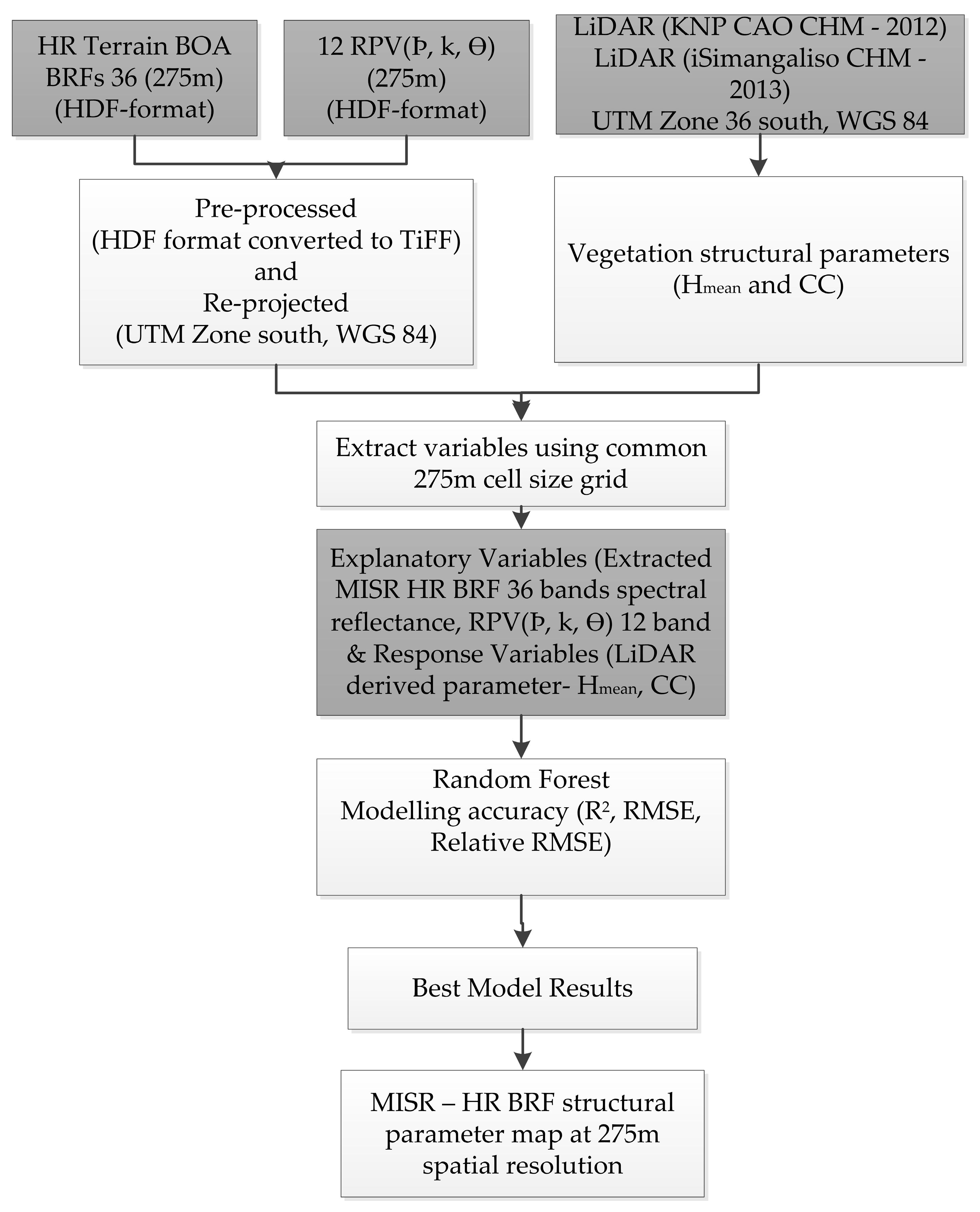
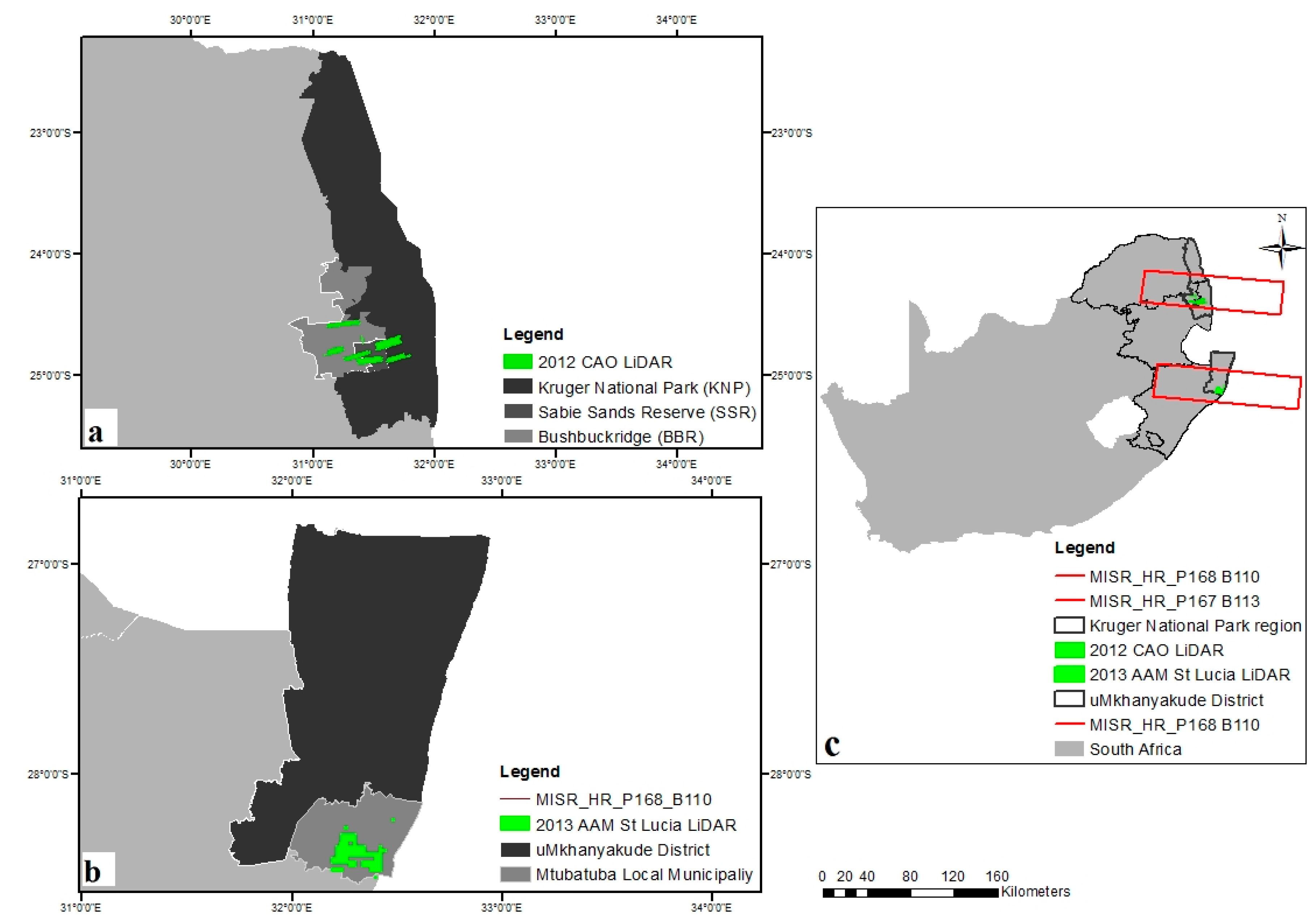
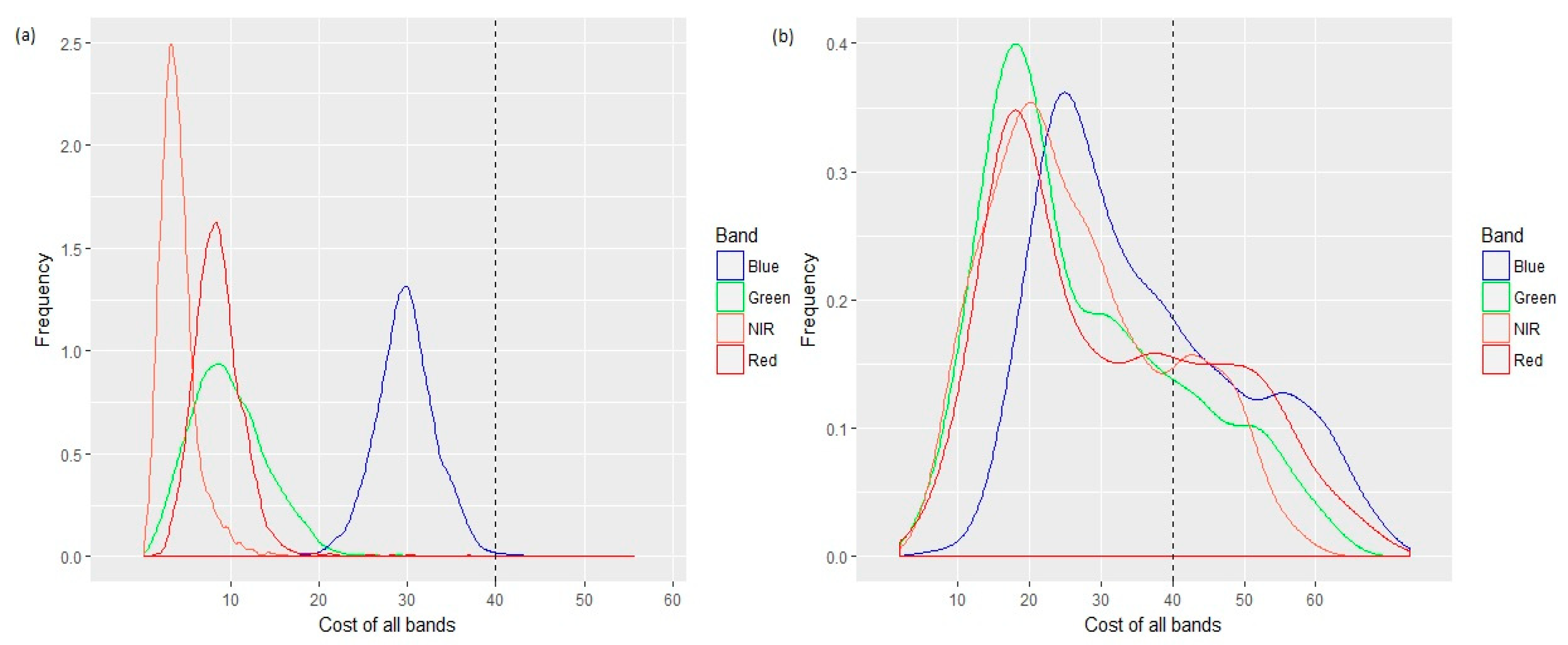
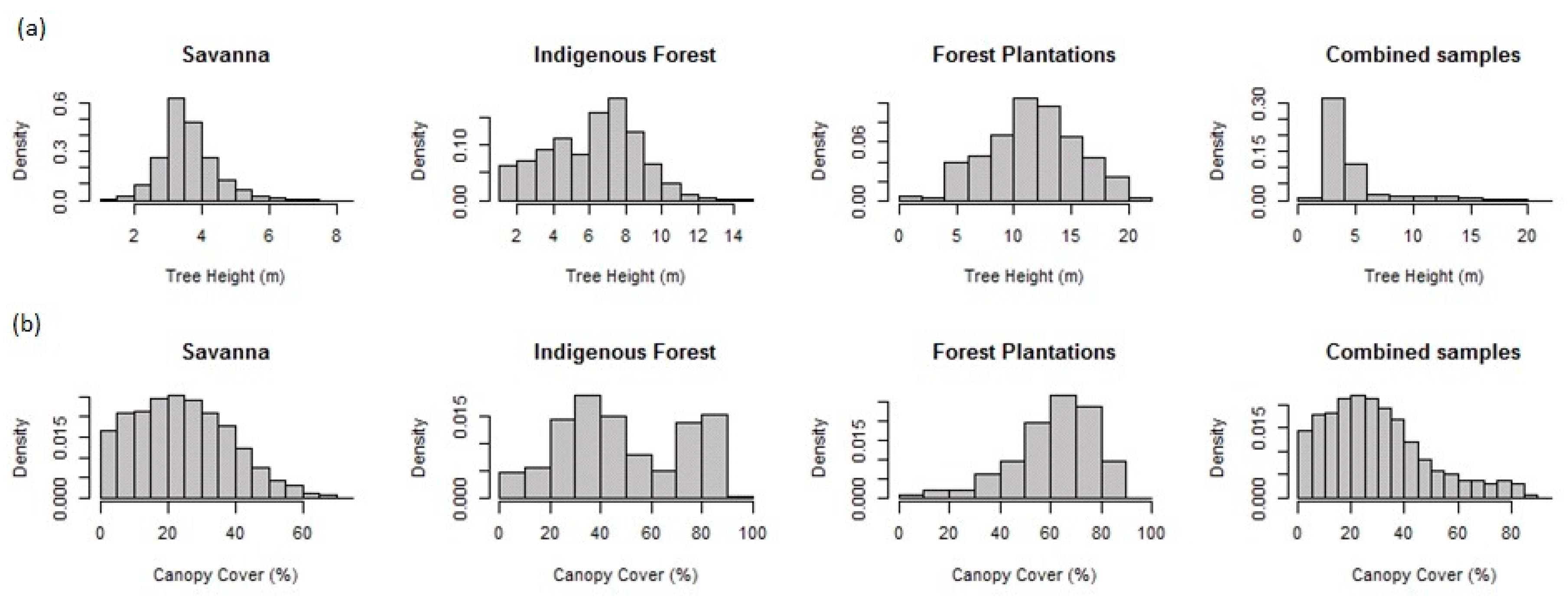

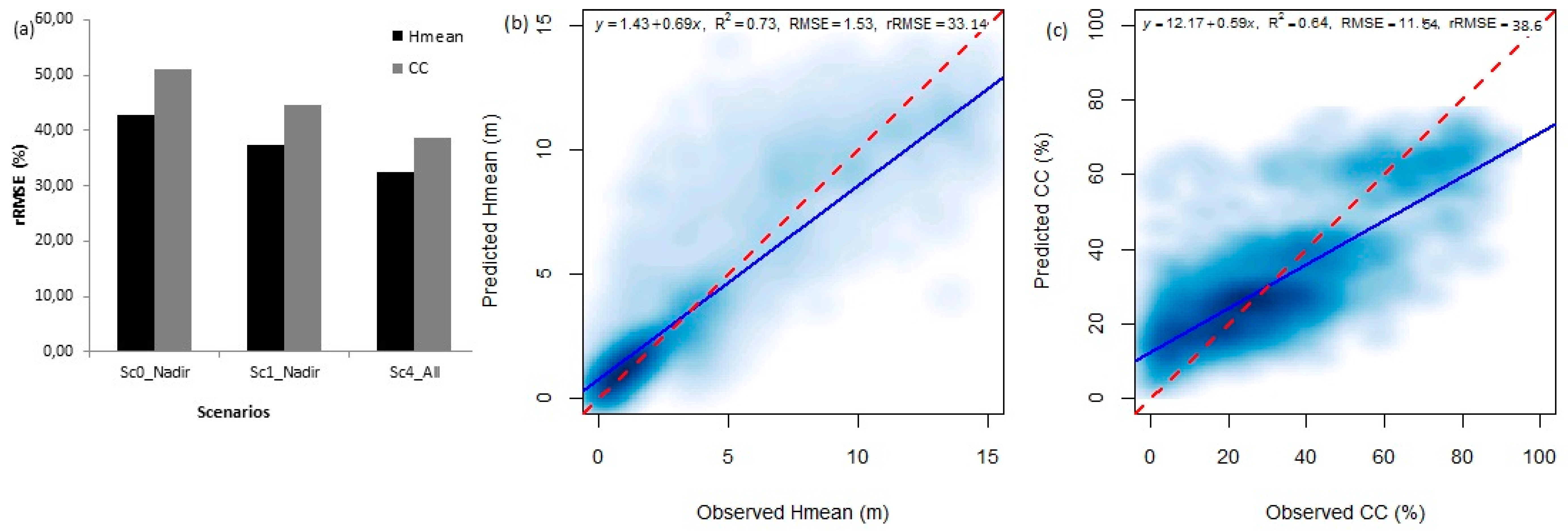
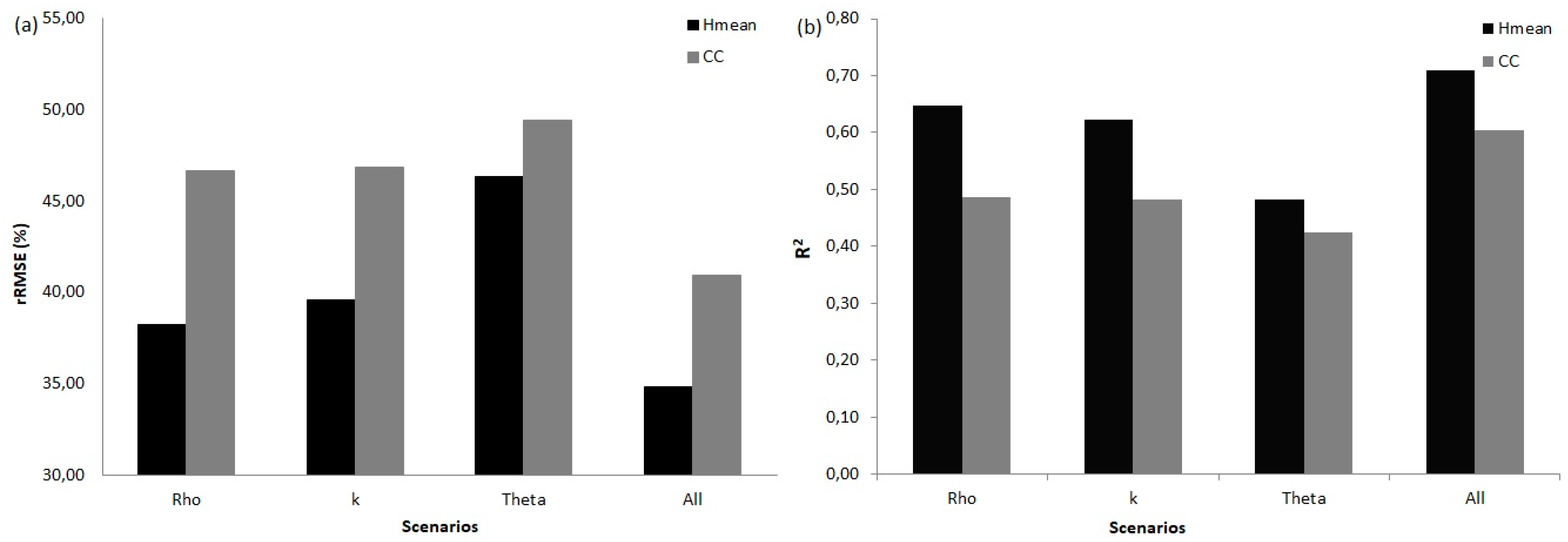
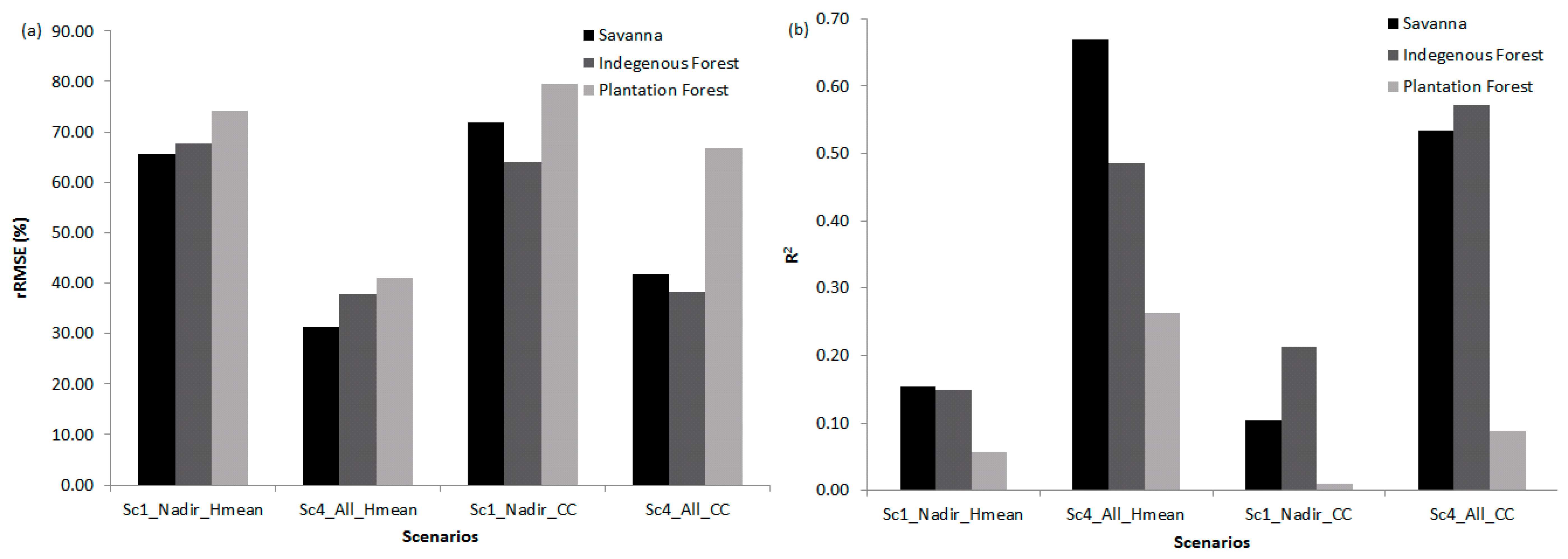
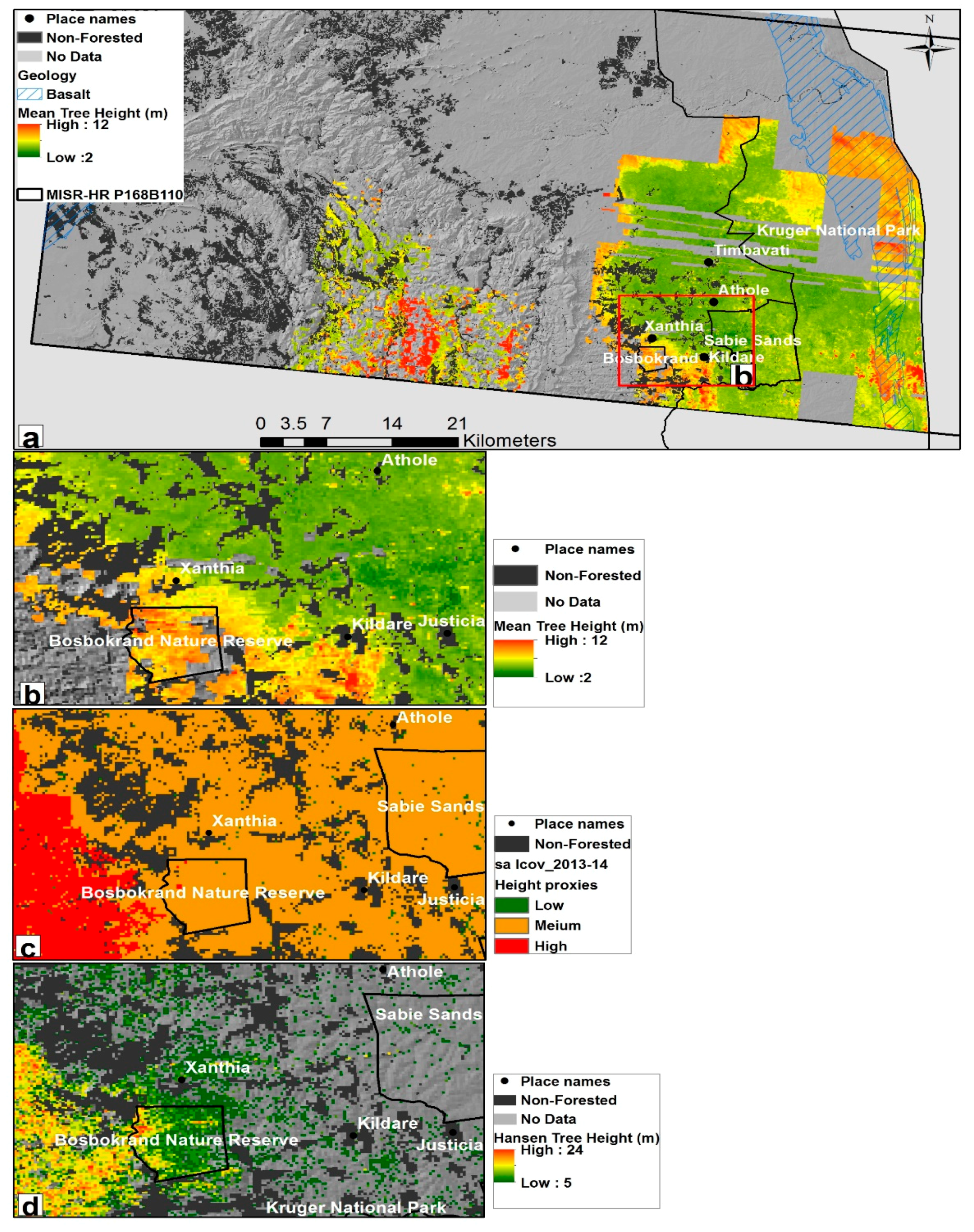
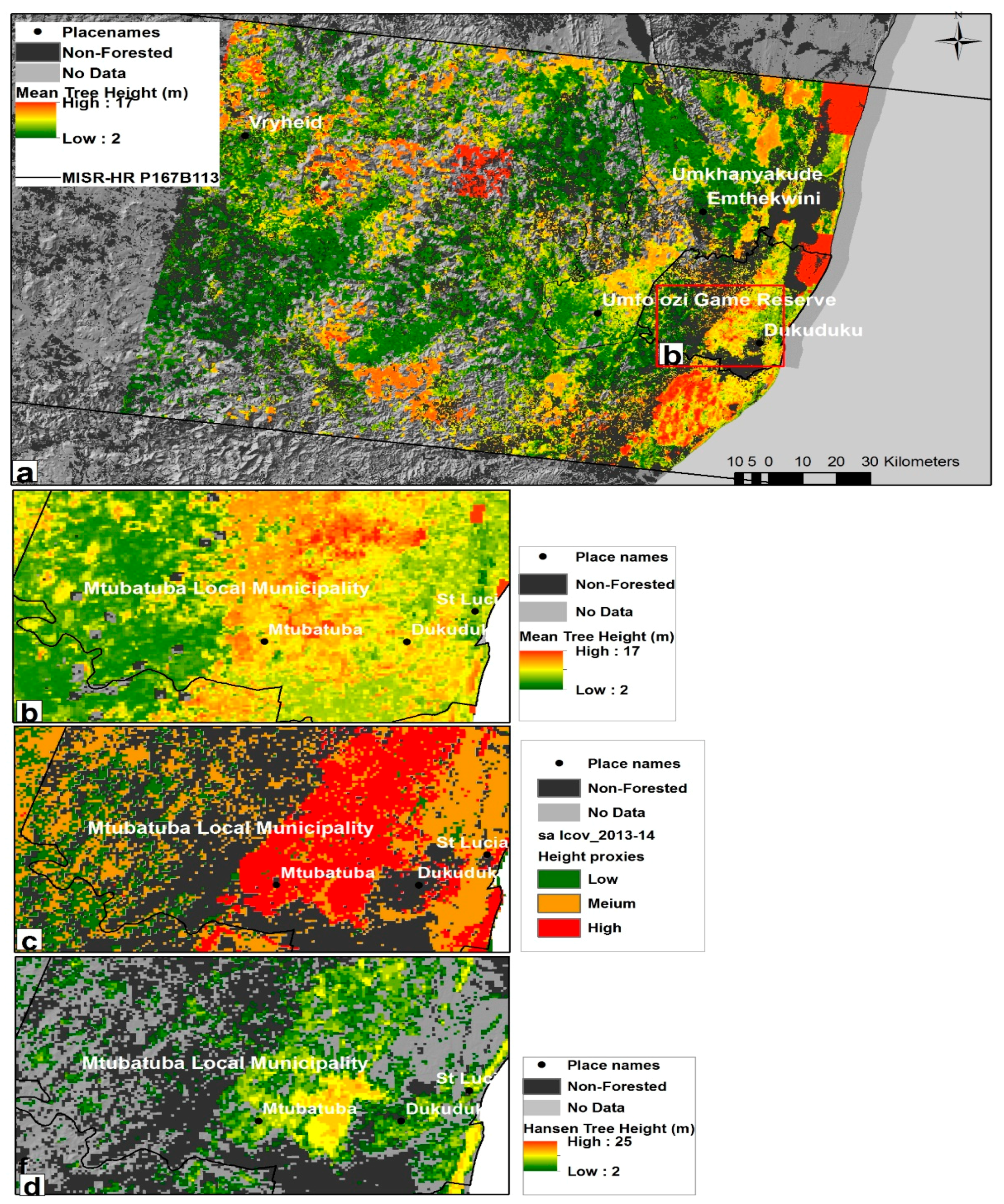
| Lowveld-Savanna n = 6150 | iSimangaliso St-Lucia Indigenous Forest n = 439 | iSimangaliso St-Lucia Forest Plantation n = 755 | Combined Samples n = 7344 | |||||
|---|---|---|---|---|---|---|---|---|
| Parameters | Hmean | CC | Hmean | CC | Hmean | CC | Hmean | CC |
| (m) | (%) | (m) | (%) | (m) | (%) | (m) | (%) | |
| Mean | 3.6 | 24.3 | 6.19 | 48.9 | 11.7 | 50 | 4.6 | 29.6 |
| SD | 0.8 | 14.2 | 2.51 | 23.8 | 3.9 | 16.4 | 2.9 | 19.5 |
| Min | 1.2 | 0 | 1.02 | 0.9 | 1 | 1.6 | 1 | 0 |
| Max | 8.4 | 71.9 | 14.2 | 90.6 | 21.4 | 90.9 | 21.4 | 90.9 |
| CV | 0.2 | 0.6 | 0.4 | 0.5 | 0.3 | 0.3 | 0.6 | 0.7 |
| Target Variable | Hmean (m) | CC (%) | ||||||||||
|---|---|---|---|---|---|---|---|---|---|---|---|---|
| View-Angle a (Spectral Bands b) | No. of Inputs | R2 | RMSE (m) | rRMSE (%) | Bias | rBias (%) | No of Inputs | R2 | RMSE (%) | rRMSE (%) | Bias | rBias (%) |
| Scenario 0 Nadir (red and NIR) | 2 | 0.56 | 1.97 | 42.80 | 0.06 | 1.19 | 2 | 0.37 | 15.28 | 51.12 | 0.83 | 2.76 |
| Scenario 1 Nadir(All) | 4 | 0.66 | 1.73 | 37.36 | 0.07 | 1.43 | 4 | 0.51 | 13.36 | 44.69 | 0.21 | 0.71 |
| Scenario 2 All(blue) | 9 | 0.65 | 1.76 | 38.03 | 0.04 | 0.84 | 9 | 0.50 | 13.42 | 44.89 | 0.41 | 1.36 |
| Scenario 2 All(green) | 9 | 0.67 | 1.69 | 36.70 | 0.03 | 0.67 | 9 | 0.55 | 12.75 | 42.66 | 0.42 | 1.41 |
| Scenario 2 All(red) | 9 | 0.66 | 1.71 | 37.07 | 0.05 | 0.97 | 9 | 0.55 | 12.82 | 42.87 | 0.21 | 0.69 |
| Scenario2 All(NIR) | 9 | 0.66 | 1.72 | 37.27 | 0.02 | 0.39 | 9 | 0.54 | 13.16 | 44.22 | 0.32 | 1.06 |
| Scenario 3 Off_Nadir_Df(All) | 4 | 0.65 | 1.75 | 37.90 | 0.04 | 0.82 | 4 | 0.44 | 14.57 | 48.95 | 0.18 | 0.59 |
| Scenario 3 Off_Nadir_Cf(All) | 4 | 0.62 | 1.81 | 39.15 | 0.03 | 0.69 | 4 | 0.44 | 14.32 | 47.90 | 0.25 | 0.83 |
| Scenario 3 Off_Nadir_Bf(All) | 4 | 0.64 | 1.77 | 38.27 | 0.05 | 1.13 | 4 | 0.47 | 13.99 | 46.80 | 0.54 | 1.80 |
| Scenario 3 Off_Nadir_Af(All) | 4 | 0.66 | 1.72 | 37.29 | 0.06 | 1.30 | 4 | 0.49 | 13.58 | 45.43 | 0.32 | 1.07 |
| Scenario 3 Off_Nadir_Aa(All) | 4 | 0.66 | 1.73 | 37.44 | 0.04 | 0.87 | 4 | 0.49 | 13.59 | 45.45 | 0.45 | 1.50 |
| Scenario 3 Off_Nadir_Ba(All) | 4 | 0.66 | 1.74 | 37.68 | 0.02 | 0.35 | 4 | 0.47 | 13.88 | 46.43 | 0.47 | 1.56 |
| Scenario 3 Off_Nadir_Ca(All) | 4 | 0.66 | 1.75 | 37.83 | 0.04 | 0.93 | 4 | 0.49 | 13.89 | 46.67 | 0.04 | 0.14 |
| Scenario 3 Off_Nadir_Da(All) | 4 | 0.61 | 1.86 | 40.35 | 0.03 | 0.65 | 4 | 0.47 | 14.15 | 47.54 | 0.28 | 0.94 |
| Scenario 4 All(All) | 36 | 0.73 | 1.53 | 33.14 | 0.01 | 0.30 | 36 | 0.64 | 11.54 | 38.58 | 0.27 | 0.91 |
| Target Variable | Hmean (m) | CC (%) | ||||||||||
|---|---|---|---|---|---|---|---|---|---|---|---|---|
| RPV Parameters a | No of Bands | R2 | RMSE (m) | rRMSE (%) | Bias | rBias (%) | No of Bands | R2 | RMSE (%) | rRMSE (%) | Bias | rBias (%) |
| Scenario 5 ρ0 (All) | 4 | 0.65 | 1.76 | 38.22 | 0.00 | 0.00 | 4 | 0.49 | 13.90 | 46.69 | −0.05 | −0.15 |
| Scenario 5 k (All) | 4 | 0.62 | 1.83 | 39.59 | 0.01 | 0.24 | 4 | 0.48 | 13.94 | 46.84 | 0.00 | 0.01 |
| Scenario 5 Θ (All) | 4 | 0.48 | 2.14 | 46.32 | −0.01 | −0.11 | 4 | 0.43 | 14.71 | 49.42 | 0.14 | 0.47 |
| Scenario 5All (All) | 12 | 0.71 | 1.61 | 34.84 | 0.01 | 0.10 | 12 | 0.60 | 12.19 | 40.96 | 0.04 | 0.13 |
© 2018 by the authors. Licensee MDPI, Basel, Switzerland. This article is an open access article distributed under the terms and conditions of the Creative Commons Attribution (CC BY) license (http://creativecommons.org/licenses/by/4.0/).
Share and Cite
Mahlangu, P.; Mathieu, R.; Wessels, K.; Naidoo, L.; Verstraete, M.; Asner, G.; Main, R. Indirect Estimation of Structural Parameters in South African Forests Using MISR-HR and LiDAR Remote Sensing Data. Remote Sens. 2018, 10, 1537. https://doi.org/10.3390/rs10101537
Mahlangu P, Mathieu R, Wessels K, Naidoo L, Verstraete M, Asner G, Main R. Indirect Estimation of Structural Parameters in South African Forests Using MISR-HR and LiDAR Remote Sensing Data. Remote Sensing. 2018; 10(10):1537. https://doi.org/10.3390/rs10101537
Chicago/Turabian StyleMahlangu, Precious, Renaud Mathieu, Konrad Wessels, Laven Naidoo, Michel Verstraete, Gregory Asner, and Russell Main. 2018. "Indirect Estimation of Structural Parameters in South African Forests Using MISR-HR and LiDAR Remote Sensing Data" Remote Sensing 10, no. 10: 1537. https://doi.org/10.3390/rs10101537





